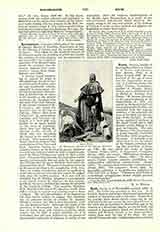

Rocamadour, communal chief town of the canton of Gramat, district of Gourdon, Department of Lot, in the Diocese of Cahors and the ancient province of Quercy. This village by the wonderful beauty of its situation merits the attention of artists and excites the curiosity of archaeologists; but its reputation is due especially to its celebrated sanctuary of the Blessed Virgin which for centuries has attracted pilgrims from every country, among them kings, bishops, and nobles.
A curious legend purporting to explain the origin of this pilgrimage has given rise to controversies between critical and traditional schools, especially in recent times. According to the latter, Rocamadour is indebted for its name to the founder of the ancient sanctuary, St. Amadour, who was none other than Zacheus of the Gospel, husband of St. Veronica, who wiped the Savior’s face on the way to Calvary. Driven forth from Palestine by persecution, Amadour and Veronica embarked in a frail skiff and, guided by an angel, landed on the coast of Aquitaine, where they met Bishop St. Martial, another disciple of Christ who was preaching the Gospel in the southwest of Gaul. After journeying to Rome, where he witnessed the martyrdoms of Sts. Peter and Paul, Amadour, having returned to France, on the death of his spouse, withdrew to a wild spot in Quercy where he built a chapel in honor of the Blessed Virgin, near which he died a little later. This marvellous account, like most other similar legends, unfortunately does not make its first appearance till long after the age in which the chief actors are deemed to have lived. The name of Amadour occurs in no document previous to the compilation to his Acts, which on careful examination and on an application of the rules of the cursus to the text cannot be judged older than the twelfth century. It is now well established that St. Martial, Amadourss contemporary in the legend, lived in the third not the first century, and Rome has never included him among the members of the Apostolic College. The mention, therefore, of St. Martial in the Acts of St. Amadour would alone suffice, even if other proofs were wanting, to prove them a forgery. The untrustworthiness of the legend has led some recent authors to suggest that Amadour was an unknown hermit or possibly St. Amadour, Bishop of Auxerre, but this is mere hypothesis, without any historical basis. Although the origin of the sanctuary of Rocamadour, lost in antiquity, is thus first set down along with fabulous traditions which cannot bear the light of sound criticism, yet it is undoubted that this spot, hallowed by the prayers of innumerable multitudes of pilgrims, is worthy of our veneration. After the religious manifestations of the Middle Ages, Rocamadour, as a result of war and revolution, had become almost deserted. Recently, owing to the zeal and activity of the bishops of Cahors, it seems to have revived and pilgrims are beginning to crowd there again.
LEON CLUGNET

